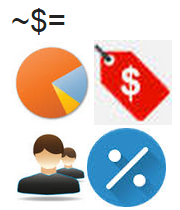Memory champion Wang Feng uses a very simple and efficient chunking method. Wang Feng is arguably the fastest mnemonist alive, so his method works. The simplicity of this method is only superficial, and you need a lot of practicing to master it – more than other methods we teach. Influenced by the structure of his native Chinese he uses very simple markers and then chunks the simple markers in 2×2 grid and remembers the whole grid as one more complex marker.
If you work with definitions and formulas you do not have enough details to create complex markers from the text. Instead, we recommend creating simple markers. Simple markers look like pictograms, clip-arts, characters, icons: a very simple depiction of complex ideas. If you want examples use google image search with search tools -> type -> clipart turned on. Our 20 images exercise uses this sort of images, and many students find very challenging to work with this sort of abstraction.
An example:
DG
How shall I create and structure markers for several things like in paragrath below:
“Such application contains a description of the relevant goods, the target market and competitors, rough estimates regarding the size of the market, the price of goods, duration and cost of the work to create new products, the cost of production and profit margins…”What I need to remember:
Rough estimates of
– Market Size
– The price of goods
– The cost of work
– Revenues
How do I do that?LG
Chunking 2×2 works quite well. You visualize the whole chunk at once. Very fast, and mo stories required. I learnt this method from Chinese memory champion Wang Feng
Lists of up to 16 items can be generated as 2×2 structure of 2×2 structures.That’s why our exercise has 20 items: to push beyond this limitation.
Why does a perfect grid have 4 items? Notice, quite often linking and chunking happens in a different context than marker creation. The context switching slows you down: remember multitasking exercises. The context switch is happening because our working memory is of limited size. The working memory size is 7+-2 objects. 4 X (objects for chunking) + (the resulting marker) + (the link to a previous marker) + (the room to place the resulting marker) = 7 objects! This means that this way we use all the working memory, and have no context switching.
Why are we arranging the objects in 2×2 grid? This is the most spatially compact representation. If we need to visualize the object in one glance we do not want it to move in 3D, we do not want to scan lines and columns, we want to have razor-sharp focused visualization.
One of the things we always ask our students is personalizing the markers. How do we personalize the 2×2 grid? For example, we add a different color for each cell of the grid. We also place the grid within compartments of our memory palace. Finally, we link it to a story about the personal route: why we found this specific grid in the specific compartment.
Please notice that the processing needs to be blazing fast, otherwise we would be better off using larger chunks with context switching for linking (like Anna teaches in her 1:1 lectures). Now suppose the article we read has 5 definitions, then we create one full grid and one partial grid. And we need to place both grids within the memory structure. This is x3 more operations than creating a 5-objects grid would require. To make it worthwhile, we need to get 2×2 grid creation and linking twice as fast as 5 objects grid memorization. Such speed requires a lot of practicing. No wonder Wang Feng trains for 8 hours each day…
Even without Wang Feng super – training you can remember 2×2 grids effectively. Start now, and with time you will memorize as fast as a champion!

Get 4 Free Sample Chapters of the Key To Study Book
Get access to advanced training, and a selection of free apps to train your reading speed and visual memory


Hi Dr. Lev,
Are we literally envisioning a 2×2 grid as if a poster was posted on a wall containing these items somewhere in the memory palace?
And if so, then it’s suggested to color code? e.g “orange basketball, blue butterfly, yellow dandelion, white beaker”?
Or by the grid does that mean make a quick marker with 4 the items? As in “a beaker shoots out a basketball which explodes a yellow dandelion that turns into a blue butterfly”, then the butterfly flies off to the next place of the memory palace.
Or could you perhaps give an example of how the grid in the example above would be made into one more complex marker?
Would it be something like “the bottom left icon with the front person having the top right icon as a pin on their shirt, holding up a piece of paper with a pie chart and [$]/percentage symbol?”
Thank you for your time.
Please send me a mail to [email protected] and I will reply with a short preprint from the book.